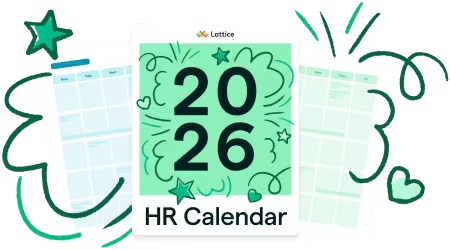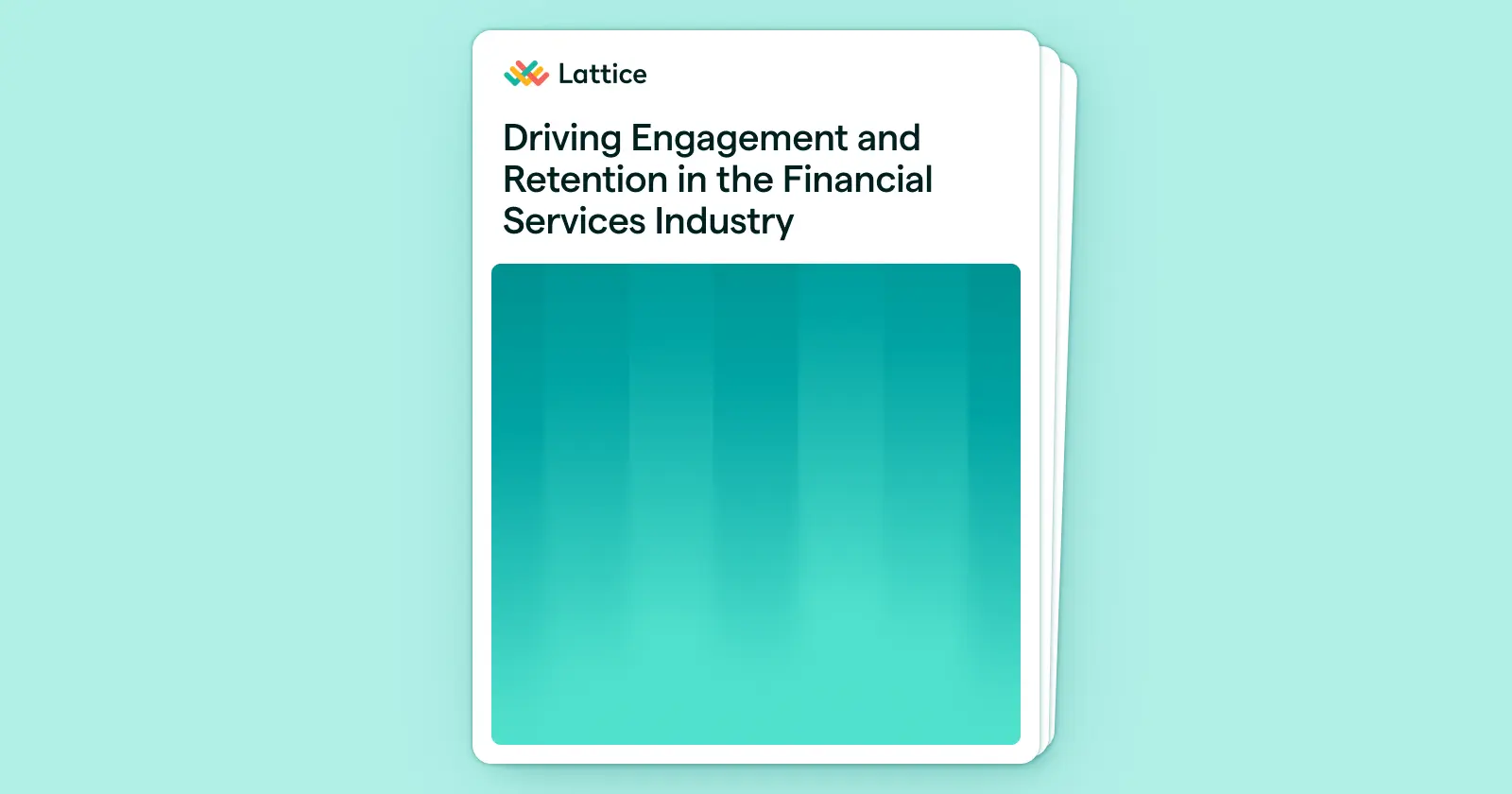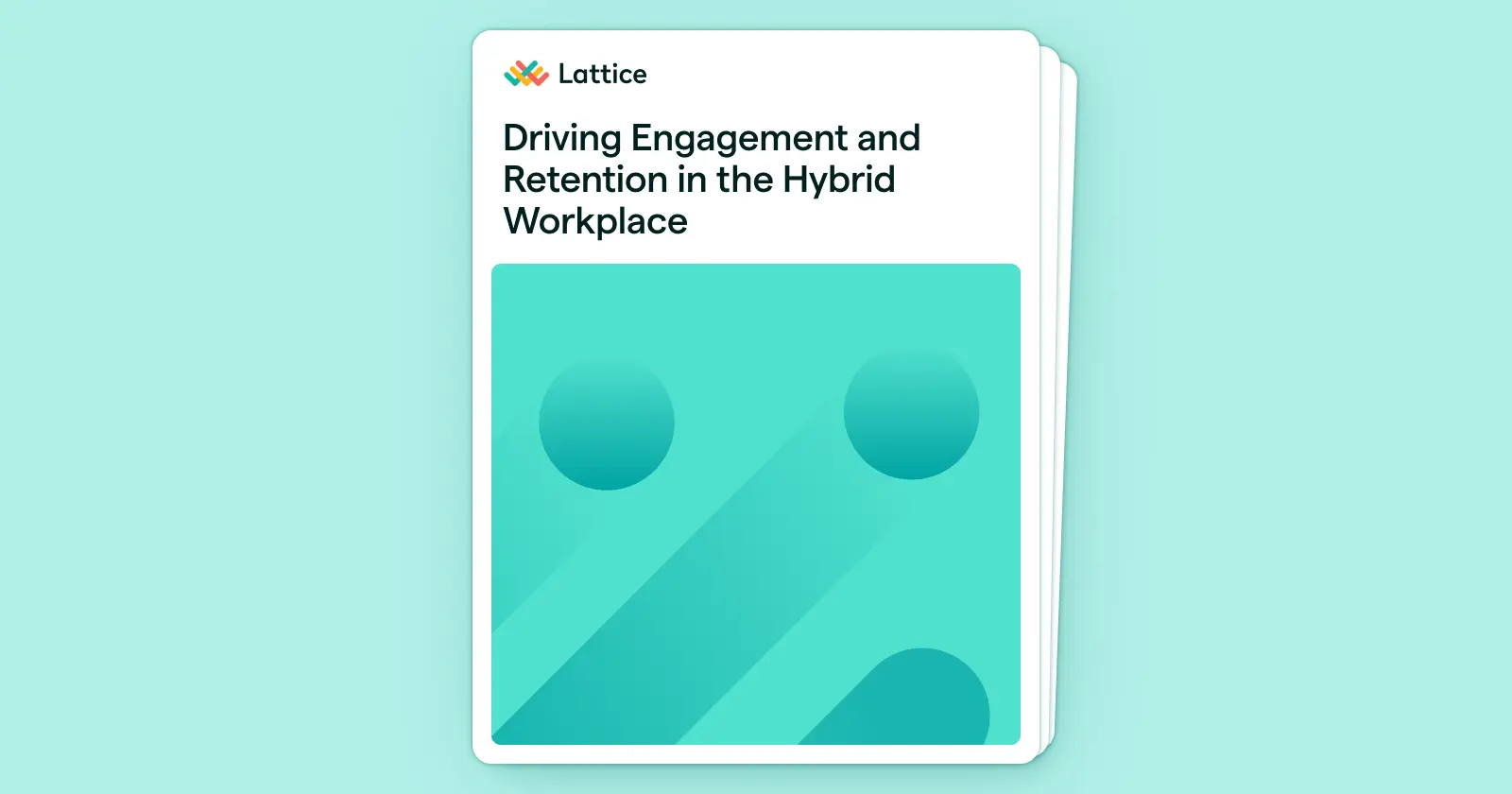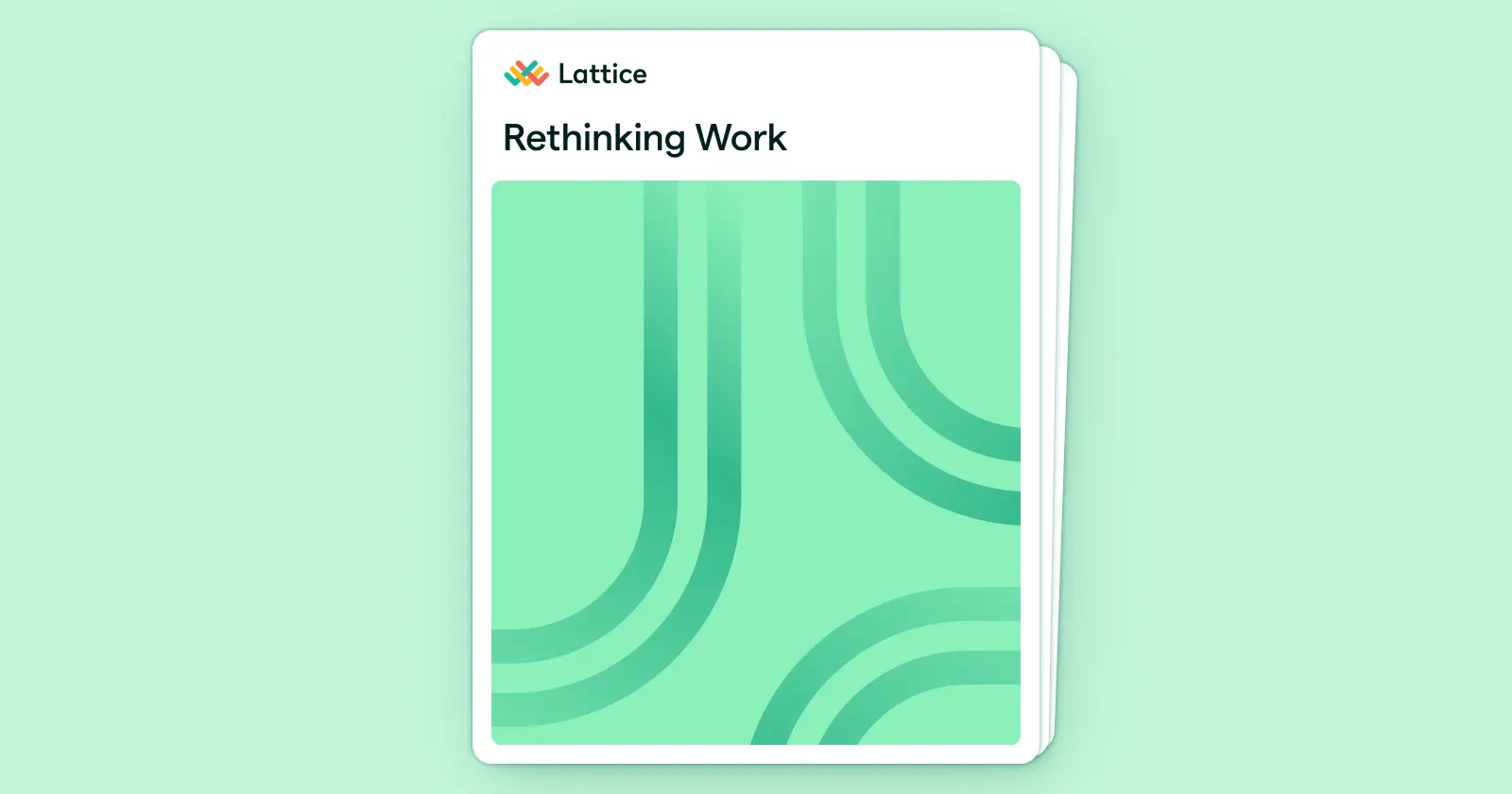Performance and Engagement: Better Together


Integrating engagement and performance can add up to some big wins for your organisation. The problem is, where do you start? And how can you build a people strategy and operational framework that leverages both to their fullest potential?
In this ebook, we’ll explore:
- The relationship between performance management and employee engagement
- How both have a tangible impact on the success of your people and business
- An actionable framework to integrate the two
After all that, you’ll be ready to take your first steps to build a high-performing, engaged workforce at a company where everyone feels motivated and empowered to do their best work.
Download for free now
By submitting your information, you agree to Lattice's Terms of Service and Privacy Policy. You can opt out anytime.
Thanks! We'll be in touch soon.
Introduction
You probably don’t need us to tell you that engagement and performance have always been fast friends.
A 2023 survey by Lattice and Yougov found that highly-engaged employees do their best work. They’re more productive, proactive, and motivated to contribute to your company’s success. On the flip side, high-performing employees can see how their work positively impacts their organization. They’re more likely to be engaged as a result. Crucially, they’re also more likely to stay at your organization.
Integrating engagement and performance can add up to some big wins for your organization. The problem is, where do you start? And how can you build a people strategy and operational framework that leverages both to their fullest potential?
In this ebook, we’ll explore:
- The relationship between performance management and employee engagement
- How both have a tangible impact on the success of your people and business
- An actionable framework to integrate the two
After all that, you’ll be ready to take your first steps to build a high-performing, engaged workforce at a company where everyone feels motivated and empowered to do their best work.
Why Performance and Engagement Are Better Together
Performance management and employee engagement are critical elements of your people strategy, but they have typically existed as two separate processes with different measures of success.
- Performance management typically means evaluating employee productivity and their ability to hit business targets.
- Employee engagement is equated with job satisfaction and doing our best at work.
Over the last few years, performance management has evolved into a more holistic process that encompasses an employee’s entire growth and development journey at their organization. When we consider this shift in the context of declining average tenure, the widening global skills gap, and continued economic volatility, it’s clear that integrating performance and engagement offers organizations a competitive advantage in achieving their business goals while retaining talent. Here’s why:
- Disengaged employees are likely to leave, and employee turnover costs businesses money. Gallup estimates the cost of replacing an individual employee can range from one-half to two times the annual salary. Beyond one person’s salary, turnover disrupts customer relationships, stalls teamwork, destroys morale, and often requires managers to spend more time training new employees than focusing on supporting their entire team.
- Keeping employees engaged translates to a healthier bottom line, with a highly motivated, energized workforce. A 2020 Gallup report on employee engagement found that engaged employees are 23% more profitable and 18% more productive. They demonstrate higher levels of creativity and innovation. They also have lower absenteeism and fewer safety incidents on the job.
- Engaged employees improve customer satisfaction. In 2023, the Harvard Business Review reported that when employee performance is evaluated relative to customer experience, “employees tend to become more engaged with the organization and adopt a stronger orientation to business results.” And PwC’s research found that companies investing in employee experience and customer experience were able to charge up to a 16% premium for goods and services.
Engagement fuels great performance, and performance creates highly engaged teams that will strive to do their best for your organization. In a rapidly evolving economy, creating the right conditions to engage and retain your top performers isn’t just important, it’s paramount. And when you focus on optimizing performance management and supporting employees in reaching their goals, you’re more likely to have an engaged team.
How to Integrate Engagement and Performance
Understanding the relationship between engagement and performance means you can identify what motivates your employees to bring their best selves to work. But to leverage this relationship long-term, you need to build regular processes and norms that continually tap into your employees’ need for development, recognition, and sense of competence.
We’ve distilled this approach into a four-step framework.
1. Understand how engaged your employees are.
Your highest-performing employees are likely to be among your most engaged team members. Understanding how they experience working for your organization is a great predictor of their performance.
When employees become disengaged, they’re at the highest risk of churn. But when you’re measuring engagement on a regular basis, it means that you’re better able to spot when your top performers are at risk of becoming disengaged, and take action to retain them.
Engagement surveys are an effective tool for understanding both positive and negative employee sentiment. Companies can keep an eye on how engaged their top performers are by collecting qualitative and quantitative data:

Quantitative feedback is the numerical data you collect from your engagement scores, as well as by measuring eNPS (how likely your employees are to recommend your organization as a place to work). It helps you capture the sentiment of your workforce and track trends over time.

Qualitative feedback provides richer context into how your employees are feeling. It’s helpful for identifying frustrations and roadblocks. You can collect qualitative feedback in real-time scenarios, such as regular one-to-one meetings or conversations, or from employee surveys.

By collecting both types of data, you’ll have a much better understanding of how your employees are feeling. And when you segment this data by your top performers, you can unlock greater insight into exactly which drivers are impacting your top performers’ engagement.
This is because employee performance doesn’t exist in a silo. Your employees are whole, complex humans, and they don’t exist solely to hit targets and KPIs. Viewing their performance in the context of how they’re feeling at work can help HR leaders and managers understand what needs to change so employees can do their best work.
For example, digging into your marketing team engagement data might reveal that your top performers in one office are feeling disengaged due to management issues. This insight helps you identify your most at-risk segments and make proactive changes› to avoid high attrition or turnover rates. When you complement this insight with other data sources, such as employee tenure, promotion frequency, and exit data, you can better understand how to help your top performers thrive at work.
2. Create ample opportunities for recognition and feedback.
Humans are hardwired to crave recognition. Whether it’s getting that coveted gold star at school, or being celebrated for our contributions at work, recognition is all part of an ancient biological chain reaction designed to make us feel good for a job well done.
Getting feedback on how we’re doing at work — whether positive or developmental — has a huge impact on our happiness. A 2023 survey by Lattice and Yougov found that regular praise and recognition was one of the top five things employees need in order to do their best work.
A 2022 Gallup and Workhuman report on recognition in the workplace uncovered that when recognition efforts are done right, employees are:
- 4x as likely to feel engaged
- 5x as likely to feel connected to company culture
- 56% less likely to be looking for a new job
- 73% less likely to feel burned out “always” or “very often”
The report also found that creating a work environment where recognition is prioritized can save a large company with 10,000 employees up to $16.1 million in annual employee turnover costs.
Decades of research on employee motivation demonstrate that praise and recognition make us feel more valued at work, help us connect our contributions to a bigger picture, and increase our sense of competence in our role. Simply put, employees perform best at work when they’re happy, and recognition is a key part of fostering employee happiness.
But here’s the problem: Employees globally don’t feel they’re getting enough recognition. A 2020 Capterra report on employee recognition found that 79% of employees said they’d work harder if they felt more recognised for their contributions.
This makes positive recognition and constructive feedback immensely powerful tools in your people strategy for driving team performance — both are a high-impact, low-cost method of celebrating accomplishments, aligning on goals, and providing a direction of travel.
Implementing Processes and Norms Around Feedback
Striking the right balance when giving feedback can be tricky. A heartfelt “thank you” might help your employees feel valued, but it’s often not enough to let them know exactly what they did, or the actions they took to get there.
HR teams can facilitate greater feedback by instituting norms and processes that support regular feedback, and embedding it as part of the organization’s culture.
First, you need to ensure everyone knows what meaningful feedback looks like. According to research, the best feedback is:

Specific: A 2020 meta-analysis of the impact of feedback in classroom environments found that the most effective feedback is detailed. Employees need specific examples of what they did, and how this contributed to overarching goals so they can connect their actions to future behavior.

Timely: Recognition and feedback are far more impactful in real-time because they help us immediately connect our actions to outcomes, and highlight what we need to repeat or change for next time.

Regular: Regular feedback drives individual performance, because it not only helps everyone align on goals and course-correct as needed, but it also fosters increased trust and transparency.

Actionable: Feedback is most effective when it comes with a measurable, solutions-focused mindset that helps employees plan their next steps.
Feedback helps us internalize new behaviors, change our habits, and take in new information. If you’re vague on the details, your employee won’t know how to repeat their behavior next time. Too late, and they’ll struggle to meaningfully connect it to the steps they took to earn your praise. Too infrequent, and you’re missing prime opportunities for learning and growth.
When feedback is specific, regular, timely and actionable, we feel a sense of reward and satisfaction. At a cellular level, it’s this warm and fuzzy feeling (or dopamine rush, if we want to get scientific) that gives us a sense of pride and pleasure in our contributions, and conditions us to repeat that behavior later.
HR teams can also connect feedback to key developmental processes to drive engagement and performance long-term:

Performance reviews: Annual or quarterly evaluations can be an opportunity to review accomplishments over a longer period, and help employees connect their achievements to longer-term goals.

Ongoing feedback: Making feedback part of your culture means providing employees with ample opportunities to give and receive it. However, make sure that your feedback culture goes both ways and that employees at all levels feel empowered to share feedback, including at a team level.

Public praise: Public praise helps employees see the impact of their work among their extended peers. Public praise can be given during a company all hands meeting, internal communication channels, social media, or employee awards ceremonies.
HR teams can extend the impact of feedback even further with thoughtful tooling. Company praise — either in person or on a messaging tool like Slack — are an effective way of communicating recognition across the whole organization. Performance management tools like Lattice, which has a built-in Praise feature, are also an impactful way of making praise visible to your whole organization in real time.

3. Leverage goal setting to drive engagement and performance.
Goals are vital for increasing motivation. Whether they take the form of a New Year’s resolution to make strides toward greater wellbeing, a practical goal to increase income, or a long-term life goal to write a novel, they’re the reason we feel that Rocky-level “Eye of the Tiger” montage when we’re fired up to achieve a new target.
In business, goals are typically connected to driving performance and business outcomes. But when goals are clear, individual, and realistic, they directly translate into higher employee satisfaction and engagement. This is because employees can connect their individual contributions to a larger context and have a clear direction on what they need to do to succeed. In short, they have tangible proof that what they’re doing matters.

These benefits alone make goal-setting one of the most impactful processes an HR team can implement from a performance and engagement perspective.
In order to set effective goals, you need to make sure they’re clear, specific, and relevant. And most importantly, your employees need to have buy-in. According to a goal-setting theory co-authored by psychologists Gary Latham and Edwin Locke, setting effective goals relies on five key principles:

Clarity: Effective goals are clear and specific. Without the right level of clarity, goals can be too vague for employees know what's expected of them or where to start. When you have a clear target to work towards, you are more likely to stay focused and motivated to achieve it.

Challenge: Goals need to be sufficiently challenging. Goals that are too easy or difficult can be demotivating. "Stretch goals" walk the fine line between unattainable and effortless. Challenging goals can inspire individuals or teams to push themselves beyond their comfort zones.

Commitment: People need to be involved in their own goal-setting process in order to set meaningful, realistic targets. Include employees in the process early on. Involving employees helps them understand broader organizational objectives and how their individual goals contribute.

Feedback: Goals must be reviewed at regular intervals and adjusted as necessary. Take the time to reflect and iterate: By evaluating what worked well and what didn't in previous iterations, you can identify areas for improvement and make adjustments accordingly.

Task Complexity: Every journey, no matter how daunting, starts with one step. Break down your larger goals into more manageable sub-goals. When goals are realistic and achievable within a reasonable timeframe, individuals are less likely to experience excessive stress or fatigue.
Latham and Locke’s research found that people are more likely to commit to a goal if they’re involved in the goal-setting process from the start. This is because when we’re personally involved in setting goals, it taps into our intrinsic motivation.
Intrinsic motivation is the simple satisfaction we get from doing something because we find it enjoyable or fulfilling, rather than because we’re being influenced by external factors, like a performance bonus, deadline, or threat of punishment. It’s the reason we’ll go the extra mile on a project we enjoy at work, help with onboarding a new team member, or share our knowledge with a peer.
The problem is that business goals are, by definition, extrinsically motivating. They often involve imposed targets, like revenue or customer growth.
When managers involve employees in the goal-setting process, employees feel they have a voice in setting targets that are meaningful, fair, and realistic. And a Gallup report on performance management found that employees involved in this process are 3.6 times more likely to be engaged than their peers.
Building Goal-setting Processes
While there isn’t a universal or “best” method of setting goals, researchers agree that setting goals at regular intervals, such as on a quarterly basis, is the most effective way to drive performance. Setting SMART goals and OKRs are effective frameworks that help employees add specificity and context around how these goals matter to business success.
Devised by Peter Drucker, the concept of SMART goals is based on an acronym that stands for specific, measurable, achievable, relevant and time-bound. SMART goals can drive a sense of urgency and measurable criteria that define success. They focus more on achieving an objective, rather than measuring results. Objectives and key results (OKRs) are another impactful way of setting goals. OKRs are based on two questions:
- Where do I want to go? (Your objective)
- How do I get there? (Your key results)
OKRs are a powerful way of setting goals that connect your objectives with the results you want to achieve. The OKR framework is based on setting intentionally challenging goals, and quantifying their level of success.
Whichever approach you choose, frequent check-ins on progress are a great predictor for success — especially when progress is publicly reported.

Taking an employee-centric approach to goal setting maximizes this impact even further. When employees are involved in the goal setting process and understand where their contributions fit in with your objectives for business performance, they’re likely to take a greater sense of ownership on monitoring their own progress. And when completed goals are celebrated, this translates directly into higher levels of engagement and performance.
4. Make growth conversations a regular part of your cadence, not just during annual reviews.
When we think about growth and performance management, we tend to think about it in the context of optimizing employee productivity, and how high performance positively impacts profitability. That’s not wrong — but it is a bit one-sided.
If you want to maximize these metrics long-term, you must consider how investing in your employees’ personal and professional growth plays a key role in your organization’s success.
Lack of career development consistently ranks as one of the top reasons employees leave their organization. Our 2021 career progression survey revealed that 76% of employees would be somewhat or very likely to leave a company due to feeling dissatisfied with the growth opportunities on offer. Almost half of respondents said they were actively looking or considering looking for a new role that offered them better growth opportunities.
When employees feel they have nowhere to grow, they’re likely to become disengaged, which has a significant impact on their productivity and performance.
But this situation is completely reversible. A 2020 report on L&D from MindTools found that companies with engaged learners are 12% more likely to increase productivity and 28% more likely to respond quickly to changing market conditions.
Investing in employee development has an impact that extends far beyond just improving employee retention and engagement. Organizations that provide thoughtful learning and development (L&D)initiatives increase employee creativity, build a better employer brand, and enjoy reduced costs associated with hiring and talent acquisition. They’re also better equipped to shield themselves from the impact of the digital skills gap, because they’re focused on developing top talent from within.
Creating a Framework for Regular Growth Conversations
Employee development works best when it’s structured, specific, and regular. This is because, much like setting performance goals, growth plans work best when employees know what their next steps look like.
Without structure and regularity, growth can feel ambiguous — meaning employees can’t see what their future looks like at your organization. And as other priorities come up, the lack of a formalized, regular process risks communicating to your employee that their individual personal and professional growth isn’t high on your priority list. Structured L&D initiatives can include:
- Measuring employee performance before and immediately following a training, and then again at the 12, 18, or 24-month mark.
- Implementing assessments in real-time on projects through work-based learning.
- Offering L&D topics that are aligned with team and business goals, or ask for employee input to increase participation rates.
- Having managers conduct developmental reviews halfway through each performance review cycle.
- Requiring employees to fill out an individual development plan (IDP) with the help of their manager, and spend time reflecting on their progress in developmental reviews, and in regular one-on-ones.
While some organizations only include developmental reviews as part of their employees’ annual review cycle, this approach means they fail to capture and respond to their employees’ evolving needs over the course of the year. In a competitive talent market where average tenure continues to decline, these needs can change very quickly. And if your employees don’t feel like their growth needs are being met, they’re not going to hang around for their next annual review to let you know.

Bringing growth conversations into shorter, more frequent meetings means organizations can keep employee growth ticking over. Managers can make development a priority year-round, by weaving development conversations into regular meetings like one-to-ones, or by checking in on a monthly or quarterly basis to surface new career aspirations.
Adding structure to this process can also help eliminate ambiguity around next steps. Formalizing job levels and competencies and giving employees clarity over internal promotion frameworks means that they know exactly what they need to do to reach their career and development goals.
Conclusion
Performance management and employee engagement strategies are two sides of the same coin. When employees are engaged, they perform better. When they perform better, they’re more engaged and bought in to seeing your organization succeed. When you integrate the two in a platform like Lattice, you gain vital insight into what motivates your employees to bring their best selves to work on a daily basis.
Our people analytics dashboard gives you visibility into sentiment among high performers, specific departments, demographics, and other criteria. Because both data sets live within the platform, you won’t need to reconcile them with a separate tool.
Remember, it’s not enough to simply monitor performance and engagement — you also need to take action to encourage both long-term. Creating thoughtful frameworks and processes around goal-setting and employee development will give your employees clarity on how their goals connect to your organization. This means every dollar and minute you invest in supporting employee engagement and performance will pay dividends for your business outcomes.

Your people are your business
Ensure both are successful with Lattice.




